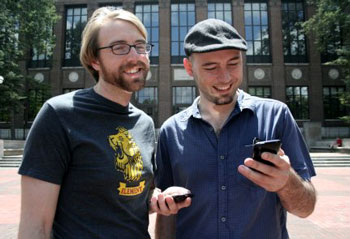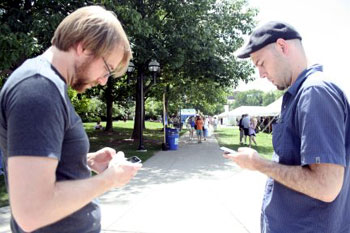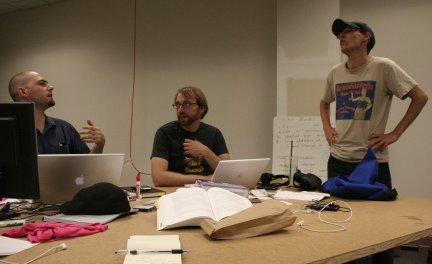Game: It’s Not Really Art, It’s Not Even Real

Jeremy Canfield and Sergio Mendez of the tech start-up Phonagle study their iPhones as they search for virtual game pieces in Ingalls Mall during the art fairs on Thursday. (Photo by the writer.)
Sergio Mendez was meandering through the art fairs crowd in downtown Ann Arbor. Walking down Washington toward Main Street, Mendez saw something worth picking up. It was the left arm – just the left arm – belonging to a guy he knows, Eric Garcia. So Mendez grabbed it and put it in his backpack.
That left arm wasn’t some sculpture in the art fair. But no worries, it also wasn’t Garcia’s literal left arm. It was a virtual arm, part of a multi-player iPhone game that Mendez and Garcia are developing, along with their colleagues at Phonagle, Jeremy Canfield and Ben Malley.
Phonagle LLC is a tech start-up. This week they’re using the art fairs as the setting to test out the game they’re developing. The object of this game: Find and collect virtual objects set up around the city – this version included their own virtual body parts.
At their downtown office in the basement of Tally Hall, Mendez explained that they intended to blend the online and offline worlds with their game. It’s meant to become a part of players’ daily lives, something they do while hanging out at a coffee shop or walking from place to place on the street.
Thursday afternoon was the first test for the game. After gathering at the entrance to their office building on Washington Street, the Phonagle members split up, with Mendez and Canfield functioning as a team and Malley and Garcia striking out in their own directions. The Chronicle shadowed Mendez and Canfield to see how the game would play out.

Jeremy Canfield and Sergio Mendez of the tech start-up Phonagle look for virtual body parts on the Diag while doing a test run of their multi-player iPhone game on Thursday. (Photo by the writer.)
Canfield explained that they had applied Photoshop filters to photos of themselves, then digitally sliced up those photos and scattered the pieces around the city, with a concentration on the art fairs. Each player started out with the torso from his photo. Rule of the game for this test: First person to find his head, arms and legs, and then reconstruct his photo would win.
Before heading out, Canfield and Mendez studied their iPhones. Using their built-in GPS capability, the phones displayed maps of the downtown area. A blue dot indicated the current location of the player. Question marks on the map indicated body parts that were virtually located within four blocks or less of the blue dot. Players could “pick up” body parts by being within about 40 feet of them.
So when Mendez picked up Garcia’s left arm, it was because he’d gotten within 40 feet of it. As the arm appeared on the screen of his iPhone, he explained that players can also trade body parts, making them “jump” from one phone to the other with a downward motion of the player’s arm. That means players in the game can pick up each other’s parts and use them to bargain for bits of their own bodies.
Mendez decided to continue toward another question mark at the intersection of Liberty and Main, while Canfield went after another nearby piece. It was slow going through the crowd on Liberty. Art fair visitors lingered around the booths, looking at wooden carvings of animals and beaded jewelry. The sun was blazing, and the scent of ice cream, sunblock and hot dogs mingled in the summer air.
Mendez eventually made his way to Main, where he found Malley’s left arm.
“I’m going to pick it up in any case, so I have trading power,” Mendez said.
Canfield returned with one of his arms and one of Malley’s. As the two of them meandered back down Liberty in their quest for more body parts, Canfield noted that the art fairs didn’t seem like the best venue for the game. Players need to move quickly to gather their pieces before others do, but the fair clogs the streets and slows the gamers’ progress.
And the players might want to stop and see the art, too.
“You’re torn because you kind of want to look at the exhibits,” Canfield said.
Despite their need for speed, Canfield and Mendez soon got waylaid at a booth for Paradise Island Gourmet Popcorn. The plastic containers with free samples of cheddar, strawberry and bacon-flavored popcorn drew them in. Soon they were munching handfuls of Jamaican BBQ and taking out their wallets to actually buy a couple bags of the bacon-flavored stuff.
“Back to the game,” Canfield announced as they left the booth, popcorn in tow.
The Phonagle duo wandered the crowded, sunny streets down State Street. They walked through Ingalls Mall, while the Black Eyed Peas’ “Boom Boom Pow” emanated from a nearby tent. Canfield forged ahead, scrutinizing his iPhone’s screen, while Mendez paused to study the menu at a booth serving Mediterranean food. No question marks showed up on their maps.
“Those guys have picked everything up,” Mendez said of Malley and Garcia.

Sergio Mendez (left), Jeremy Canfield and Ben Malley of the tech start-up Phonagle discuss possible revisions to their multi-player iPhone game in their office after testing the game out during the art fairs on Thursday. (Photo by the writer.)
After traversing North and South University and the Diag with no luck, Mendez and Canfield headed back to Liberty. On the way there, they discussed possible revisions to the game.
They agreed that they should program in “backpack limits,” allowing one player to pick up only five or six pieces at a time. Canfield also proposed that they include hints on the map, if a player isn’t close enough to even see any of the pieces as question marks. Arrows pointing in the direction of the pieces (and even telling the player the number of pieces in that direction) could keep the game’s participants from getting stuck.
Canfield also mentioned adding art fair trivia to the game, so players have to gather information and can’t “just pick pieces up.”
“What is the item in booth 74 that looks like the ocean?” Canfield gave as a potential clue.
The Chronicle first encountered Phonagle members in our report on RPM-10, an entrepreneur internship program sponsored by the University of Michigan College of Engineering Center for Entrepreneurship and RPM Ventures. The 10-week program gives student entrepreneurs funding and office space for the summer. Canfield, Malley and Garcia attend the U-M School of Information; Mendez is a recent graduate.
Back in their office an hour and a half after the start of the game, Garcia greeted Mendez and Canfield with a triumphant grin.
“I think I win,” Garcia said. He revealed that he’d picked up 15 of the 20 pieces in the game, not including the torso he started out with. Mendez and Canfield collected four pieces (not counting their torsos) … and 4 bags of popcorn. Malley collected 1 game piece … and a Starbucks beverage.
Even though he’d retrieved the most pieces, Garcia didn’t have all of his own body parts and therefore couldn’t reconstruct his photo. No one had officially won.
“Ok, we do now know we need backpack limits,” Canfield said. “But there’s also something else missing. It can’t be just a game of speed.”
Garcia called the game “really fun,” since he consistently found new question marks on his map to hunt down. It wasn’t as fun for the others, however. Canfield said they needed to fix the game so players wouldn’t log on and see an empty map if there were no pieces around.
“Every time you enter, there should be something there,” Canfield said.
Based on the test run, Canfield said the team will revise the game. They also plan on recruiting students to test it out sometime soon.
Even though the game had some glitches, the afternoon wasn’t unsuccessful.
“I have bacon popcorn now,” Canfield said. “I’m happy.”




Sounds like a cool game. That said, with location services on which I’m assuming you need to play, I would probably be able to play for an hour before my phone died.
Great idea guys. You are the future of gaming. It’s wide open. Can’t wait to see where you can take this.
Chris
I just want to say I had a great time winning.. haha.. Also, when building the game, we adjusted the intervals at which the iPhone retrieves the GPS coordinates, thereby extending the battery life a bit.
What about adding some twists like:
- you can only tell if a piece is yours or not yours; if not yours you can’t tell whose
- some pieces don’t belong to anyone, they’re just extras to confuse things (but because of the rule just above, you would only know that it isn’t yours)
- a few pieces can work for anyone (i.e. generic “left arm” can be used by anyone)
I am totally intrigued with this gaming idea. However, you definitely need to have some elements that keep all players interested. Simply following the same activity will potentially get dull. My friends and I are planning a live adventure during the art fair next year. Perhaps we should team up?